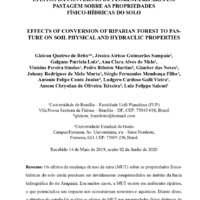EFEITOS DA CONVERSÃO DE FLORESTA RIPÁRIA EM PASTAGEM SOBRE AS PROPRIEDADES FÍSICO-HÍDRICAS DO SOLO / EFFECTS OF CONVERSION OF RIPARIAN FOREST TO PASTURE ON SOIL PHYSICAL AND HYDRAULIC PROPERTIES
Item
-
Título
-
EFEITOS DA CONVERSÃO DE FLORESTA RIPÁRIA EM PASTAGEM SOBRE AS PROPRIEDADES FÍSICO-HÍDRICAS DO SOLO / EFFECTS OF CONVERSION OF RIPARIAN FOREST TO PASTURE ON SOIL PHYSICAL AND HYDRAULIC PROPERTIES
-
Revista Espaço e Geografia
-
UnB
-
UnB
-
Description
-
UnB
-
Autor
-
Gleicon Queiroz de Brito
-
Jéssica Airisse Guimarães Sampaio
-
Galgane Patrícia Luiz
-
Ana Clara Alves de Melo
-
Vinicius Pereira Simões
-
Pedro Ribeiro Martins
-
Glauber das Neves
-
Johnny Rodrigues de Melo Murta
-
Sérgio Fernandes Mendonça Filho
-
Antonio Felipe Couto Junior
-
Ludgero Cardoso Galli Vieira
-
Amom Chrystian de Oliveira Teixeira
-
Luiz Felippe Salemi
-
Assunto
-
Cerrado
-
Infiltração de água
-
Resistência do solo
-
Uso da terra
-
Abstract
-
Os efeitos da mudança de uso da terra (MUT) sobre as propriedades físico-hídricas do solo ainda precisam ser devidamente compreendidos no âmbito da bacia hidrográfica do rio Araguaia. Em muitos casos, a MUT ocorre em ambientes ripários, o que potencializa seu impacto nos ecossistemas terrestres e aquáticos. Diante disso, o objetivo do estudo foi avaliar os efeitos da MUT nas propriedades físico-hídricos do solo de uma pastagem (anteriormente floresta ripária) em relação a uma floresta ripária. O estudo foi desenvolvido no município de Cocalinho-MT. Os ensaios de capacidade de infiltração e resistência do solo à penetração foram realizados em transectos lineares. A pastagem em ambiente ripário apresentou significativas reduções de capacidade de infiltração e aumento da resistência do solo à penetração. Isso potencializa a ocorrência de processos erosivos e favorece a degradação de ecossistemas terrestres e aquáticos. The eff ects of land-use change (LUC) on the soil physical and hydraulic properties still need to be properly understood within the Araguaia River basin. In many cases, LUC occurs in riparian areas, and the negative consequences of its impacts are relevant to both terrestrial and aquatic ecosystems. In this paper, we examined the eff ect of LUC in the pasture (previously riparian area) and to riparian area. In doing so, we selected a pasture and a forest located in a riparian area. We developed the study in the municipality of Cocalinho-MT. We performed the infi ltration capacity and soil penetration resistance assays in linear transects. The pasture had lower infi ltration capacity and higher penetration resistance, attributed to trampling. Such changes can trigger erosion, which has the potential to degrade both terrestrial and aquatic ecosystems.
-
volume
-
22
-
issue
-
1
-
Date
-
2019
-
título curto
-
UnB
-
UnB
-
Língua
-
pt
-
issn
-
2236-5656
-
Publisher
-
UnB
-
Fonte
-
UnB
-
Rights
-
Direitos autorais 2020 Revista Espaço e Geografia


